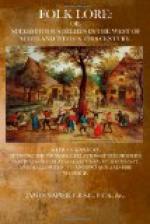Concerning the name Druid, the writer in the Encyclopedia Metropolitana says, “The name Druid is derived from deru, an oak.” The Druids were an order of priests; they were divided into three classes, resembling the Persian magi. The first class were the Druids proper; they were the highest nobility, to whom was entrusted all religious rites and education. The second class were the bards; they were principally employed in public instruction, which was given in verse. The third class was called Euvates; whose office it was to deliver the responses of the oracles, and to attend the people who consulted them. The knowledge of astronomy and computation of time possessed by the Druids was of a high order, and, no doubt, was the form of worship imported from Chaldea.
It is known that the Phoenicians had colonized Britain at least 1000 years B.C., and doubtless they would bring with them their form of worship, their gods being the sun, the moon, and fire. We may here find a very early source for the institution of sun-worship in these islands, if we can believe that such a very partial colonization as was effected by the Phoenicians could work a religious similarity throughout the entire island. I think it probable that sun-worship existed before the Phoenicians came to the island, but they may have elevated its practice. Following the writer in the Encyclopedia Metropolitana, we are told that in addition to their worship of the sun, the Druids “held sacred the spirits of their ancestors, paid great honour to mountains, lakes, and groves. Groves of oak were their temples, and their places of worship were open to heaven, such as stone circles. They had also a ceremony of baptism, dipping in the sacred lake, as an initiatory rite, and had also a sacrament of bread and wine. They paid great reverence to the egg of the serpent, the seed of the oak, and above all, the mistletoe that grew upon the oak; and they offered in sacrifice to the sun and fire, men and animals.”
Many of the localities where their worship was observed in this country can still be identified through the names which these places still bear. One or two are here given, because they refer to sun-worship:—
Grenach (in Perthshire), means Field of the Sun.
Greenan (a stream in Perthshire), means River of the Sun.
Balgreen (a town in Perthshire and other counties),
means Town of the
Sun.




